Hey there Japanese language learners! After a summer of trying out new Japanese study tools, the Tofugu team is here to introduce some new favorites. Whether you're headed back to school this fall or not, you can turn over a new leaf in your Japanese studies by trying out a few of these great resources! 🍂
- "Day to Day" and "Story for You" from Tree
- 日本語文型バンク
- SLOWLY
- Learn Native Japanese (LNJ)
- Learn Japanese with Noriko
- 基本語力アップ! 初級から学ぶ 日本語コロケーション
- Jisho Pitcher
- Let's Learn Japanese From Small Talk!
- にほんごボックス
- 物の名前ドリル
- 虫眼鏡の放送部
- すみっコぐらし はじめての漢字辞典
- Fluent Forever
- Gengar Podcasts
- YouGlish
- ロールプレーで学ぶビジネス日本語
- Nあ~ Casual Nihongo
"Day to Day" and "Story for You" from Tree

It can be difficult for Japanese language learners to find interesting short contemporary Japanese stories to read with English translations online. A novel can be daunting in length and complexity, while children's stories might not be interesting or relatable.
Enter the literary news site tree, from Kodansha publishers, and their web series, Day to Day. Tree, created with the goal of introducing readers to new Japanese books, released a series of short pieces by acclaimed authors — complete with professional English and Chinese translations — all around a general topic that many of us may be able to relate to: living under quarantine in 2020.
The authors range from bestselling fiction writers and essayists, to manga, mystery, and science fiction writers.
Published daily from April 1 to July 9, over 60 authors from Japan wrote about just how much their daily lives have changed or haven't. All the pieces are fairly short — perfect for a lunch break — and include portraits of everyday quarantine activities like going to convenience stores and doing giant jigsaw puzzles, as well as accounts of setting up crowdfunding sites and getting sick. Some are not related to isolation at all. The authors range from bestselling fiction writers and essayists, to manga, mystery, and science fiction writers. Each story ends with a short biography of the writer and a list of their recent works.
Open up the Japanese table of contents alongside the English (or Chinese) one, and you'll be able to test your Japanese reading skills and confirm your comprehension with the translation. If you sign up for an account with the site, you can bookmark your favorite pieces to come back to later by clicking the yellow "お気に入り" button. You'll then find them listed in the "お気に入り" section, linked in the top menu.
And if children and young adult stories are your thing, you're in luck too — tree has also published and translated over 60 short stories for children in English, Japanese and Chinese. They can all be found in the Story for you section of their website.
日本語文型バンク
For the grammar nerds out there, this one is for you! 日本語文型バンク (or "Japanese Grammar Point Bank") is a collection of grammar explanations and example sentences, created by the National Institute for Japanese Language and Linguistics (NINJAL). They create a lot of amazing tools for analyzing and learning about the Japanese language, and this one is quite a gem 💎
The tool's content is organized into categories based on communicative function: 比較 (comparison), 並列 (listing), 依頼 (requesting), and 可能性 (potentiality), to name a few. Click on a category, and you'll see subcategories listed, along with related grammar points. For example, if you click on 可能性 (potentiality), you'll see the related grammar points sorted into 可能 (ability), 容易 (simplicity), and 困難 (difficulty).
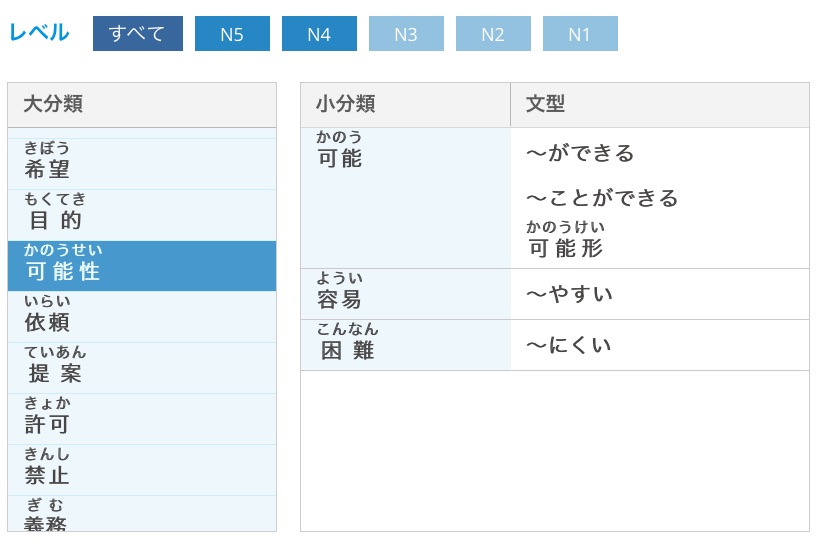
Once you click on a grammar point, an explanation window is displayed. You'll see an explanation of the grammar's meaning, as well as a list of example sentences, with audio. Other cool features of this tool include the ability to compare two related grammar points, toggle furigana on/off, and download grammar explanations as pdfs.
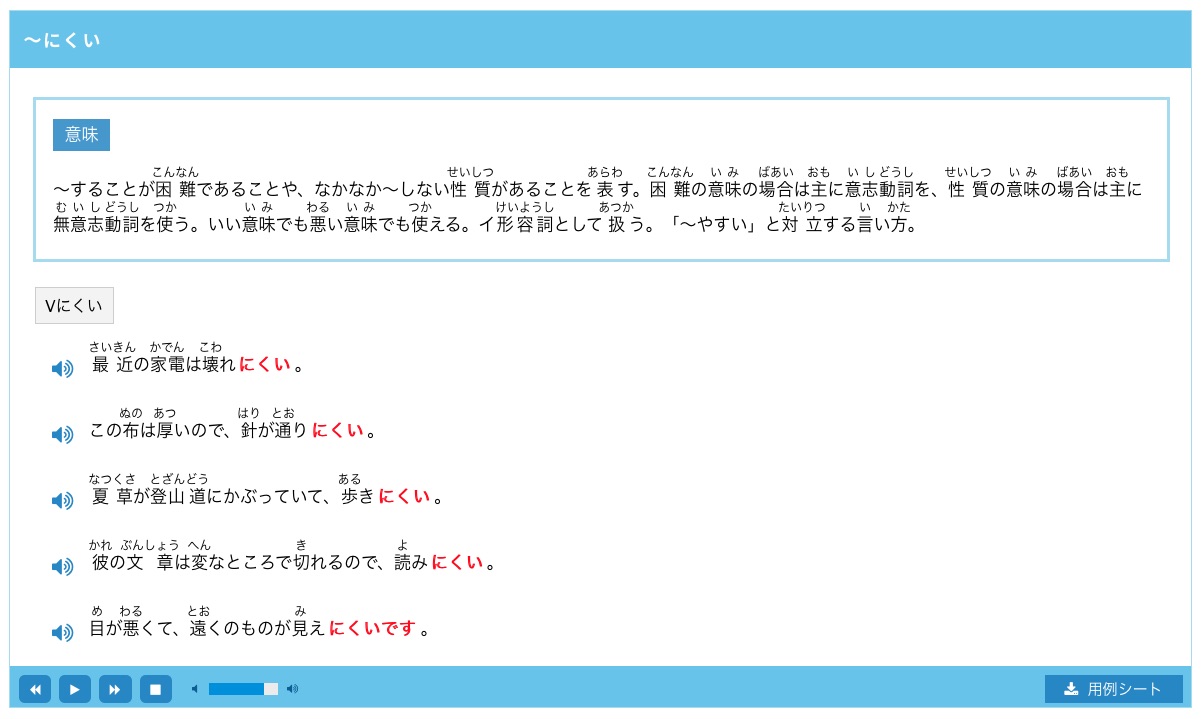
As of now, the tool only includes grammar points associated with JLPT N5 and N4. More advanced grammar points will hopefully be added in the future! Are you listening, NINJAL? 😉 Still, we highly recommend playing around with 日本語文型バンク to see how it can help you along on your learning journey.
SLOWLY
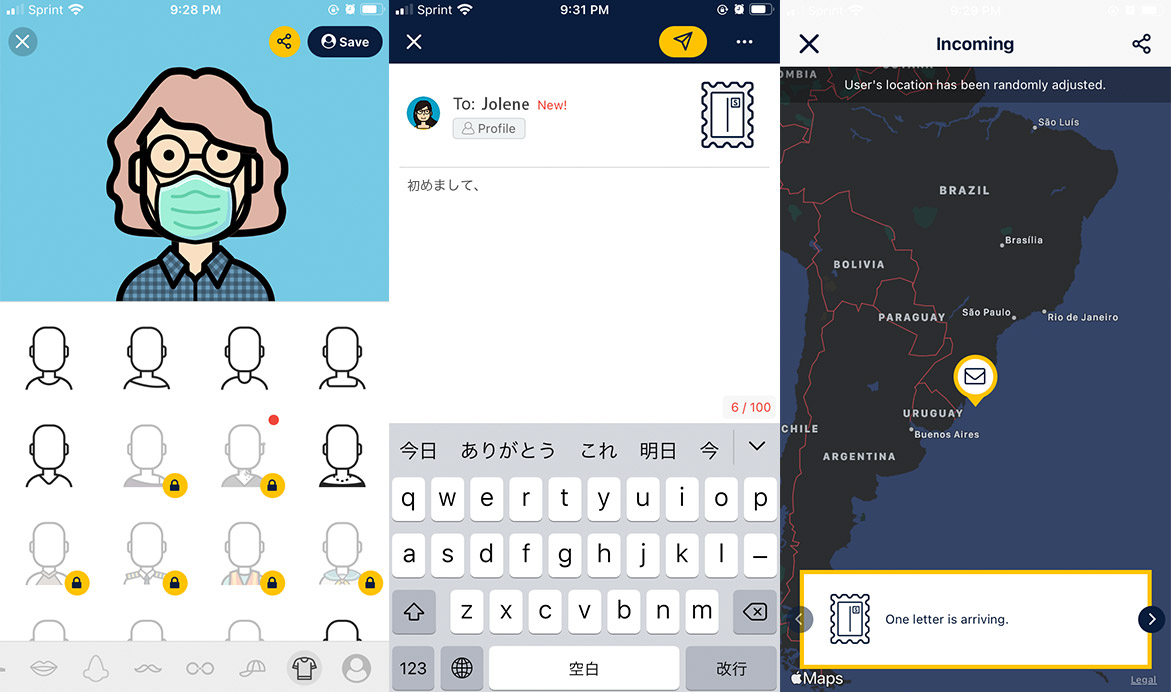
When was the last time you sat down and wrote a letter? In Japanese? SLOWLY, a free mobile app, will help you find a pen pal to write to in a variety of languages, including Japanese. No stamps or visits to the post office necessary. All letters are sent through the app itself, but not instantaneously — slowly, as the app name suggests.
Although writing letters in Japanese can be a daunting task, not to mention to more or less a complete stranger, I felt safe finding a pen pal on the app, with its strict ground rules and security features. I created a nickname, customized an illustrated avatar, and chose topics I want to (and do not want to discuss) in my letters. As for language skills, you can list all the languages you're comfortable writing in, and what level you are at, from "Interested" and "Beginner," all the way to "Fluent" and "Native."
SLOWLY is a wonderful way to practice putting your thoughts into Japanese — without the hassle or expense of postage stamps, or the stress of email.
You can choose to have the app automatically match you with people, or you can turn off that setting and find people on your own. I was able to narrow down other potential letter writers by language, topics, region (country), age range, gender (women, men, non-binary) and even astrological sign. I was surprised and delighted to find and read the profiles of Japanese writers of all levels from around the world, not just in Japan. I found two people who sounded compatible with me, and sent each of them a letter in Japanese.
A week after I wrote and sent the letters, I got a notification that a letter in response was on its way. I eagerly awaited the letter's arrival. Once it arrived, it was a little hard for me to look up words I didn't know on my phone. Using SLOWLY's web app, though, made it a lot easier for me to select and copy words that were new to me and also draft my response.
For intermediate to advanced learners who want to hone their writing and reading skills in a social setting, SLOWLY is a wonderful way to practice putting your thoughts into Japanese — without the hassle or expense of postage stamps, or the stress of email. Bonus points for an app that incorporates endearing illustrations and cute design. In a world of endless group chats and video calls, having a pen pal from another country to write to every few weeks has been educational in more than just language learning. For more tips on writing letters in Japanese, read our guide.
Learn Native Japanese (LNJ)

とりま, ぱくる, じわる, エモい… how much Japanese slang do you know? If you want to spice up your vocabulary, follow Learn Native Japanese (LNJ) on Instagram for regular doses of slang!
The account is run by two native speakers of Japanese, Dai and Ryo. Each post is a short video of them introducing a Japanese slang word or phrase, from decades-old ones to newer, currently trending ones. They explain the nuances in English, and give you example sentences to help you understand how it's actually used.
Learn some cool slang so you can be hip and impress your Japanese friends! 😉
Learn Japanese with Noriko
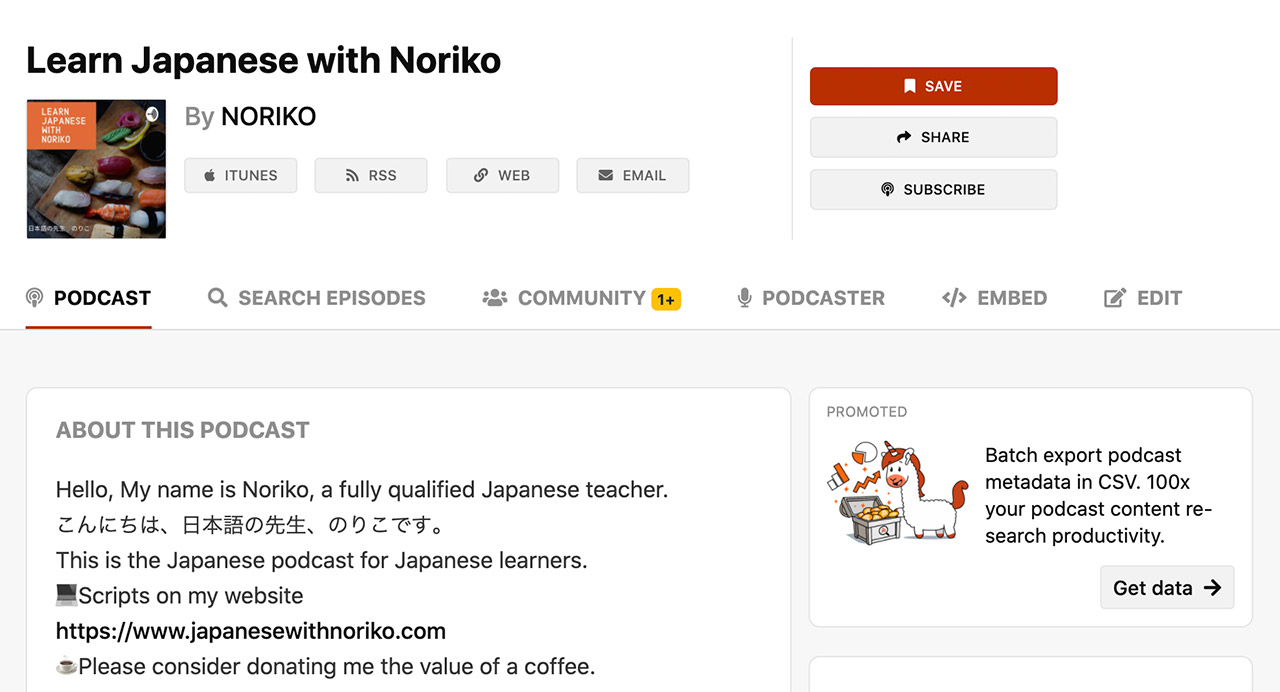
Following the mold of great podcasts hosted by Japanese teachers, Learn Japanese with Noriko is no exception. Updated almost every-other day, Learn Japanese with Noriko has grown to over a hundred episodes, and has a second season.
Noriko-sensei’s podcast is another monologue-style series, but her speech is only slightly slowed. For the most part, her speech is not limited by grammar, vocabulary, or speed, making it good practice for intermediate learners. Additionally, since the episodes are closer to 10 minutes each, it allows you to settle into the study a bit more, and forces you to stay engaged.
Additionally, there is a Patreon where members are given access to a wider range of transcripts and episodes.
基本語力アップ! 初級から学ぶ 日本語コロケーション
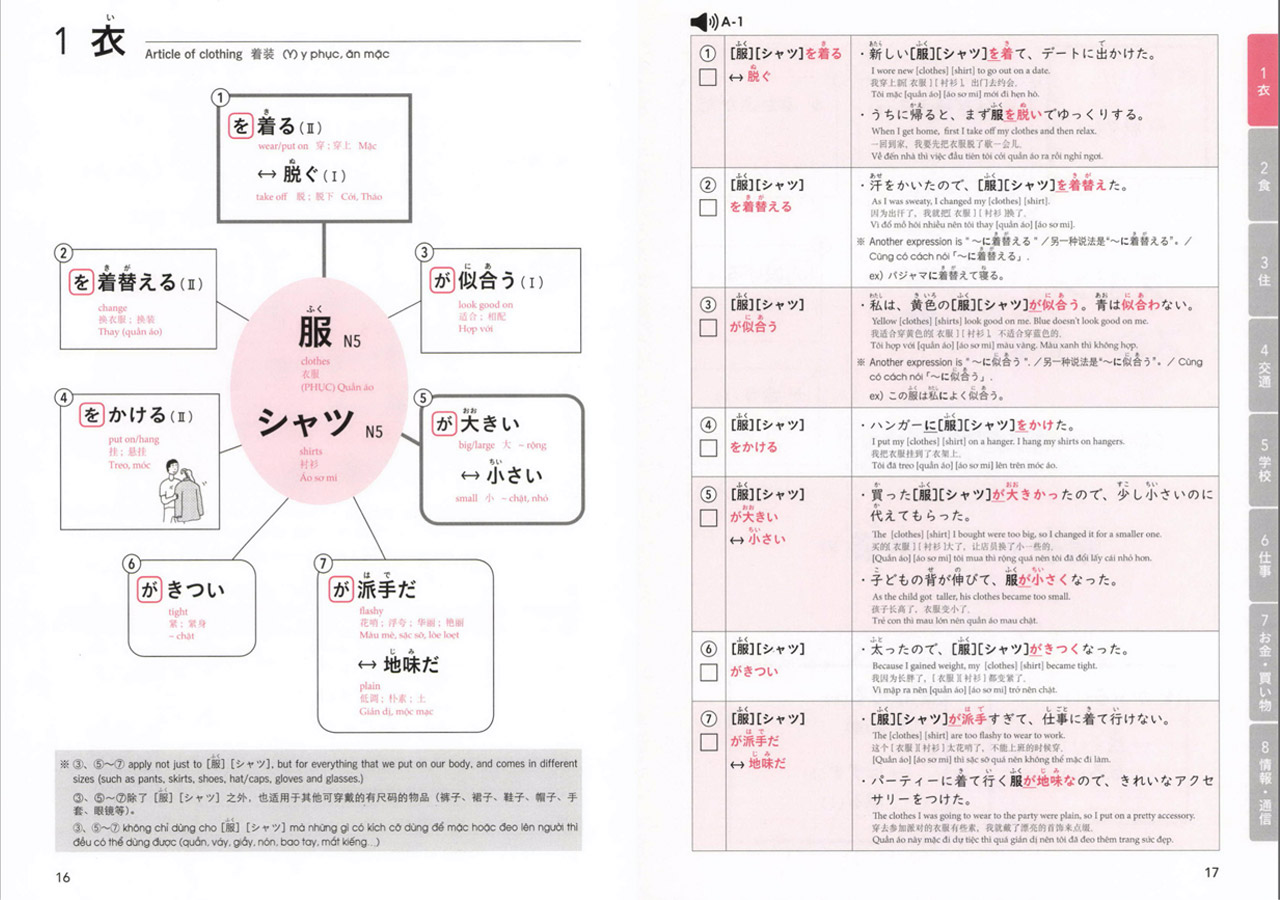
Still flipping flashcards with words and one-to-one translations on the back? You should consider building your vocabulary using collocations!
基本語力アップ! 初級から学ぶ 日本語コロケーション (Bump Up Your Basics! Japanese Collocations Associative Learning for Beginners On) teaches you not only basic words, but also words that are frequently paired with them. This is important for Japanese learning — and foreign language learning in general — because simply memorizing words and their translations doesn't necessarily mean you know how to put them together in a practical sense. For example, when the book teaches you the noun シャツ (shirt), it also introduces sets of particles and verbs that often pair with it. One of these sets is 〜を着る, and learning this helps you know how to say "wear a shirt" in Japanese. This is particularly useful because there are different verbs that mean "wear" in Japanese, depending on what type of clothes are being worn. While it's 〜を着る for shirts, it's 〜をはく for for 靴 (shoes). This is the power of learning collocations!
In addition to these collocations, the book provides simple example sentences and quizzes to review what you learned. Build your vocabulary with collocations for more effective learning!
Jisho Pitcher
Jisho Pitcher adds pitch accent information to everyone's favorite online dictionary: Jisho.org. If you're not familiar with it, pitch accent refers to the how particular words are pronounced in Japanese. A famous example is the word hashi, which can mean bridge (橋) or chopsticks (箸), depending on the intonation pattern (the rising and falling of your voice) as you pronounce the word. In all honesty, pitch accent is not very important for being understood in Japanese, which is why it's seldom taught in classrooms. However, learning about it is valuable if you aim to sound more native-like.
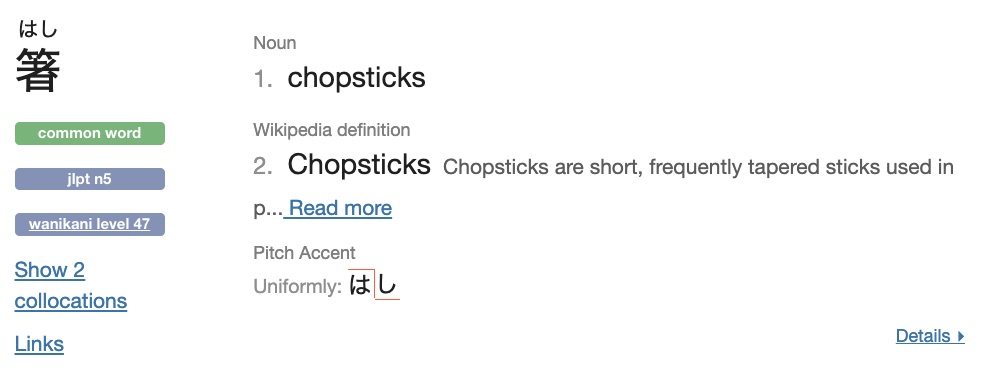
Do you see how「はし」at the bottom of the entry has red lines going up and down like a stair step? Those lines represent intonation; high-to-low for 箸 (chopsticks). Having this pop up in your Jisho searches is a really nice add-on to have, so take a second to download this extension!
Let's Learn Japanese From Small Talk!
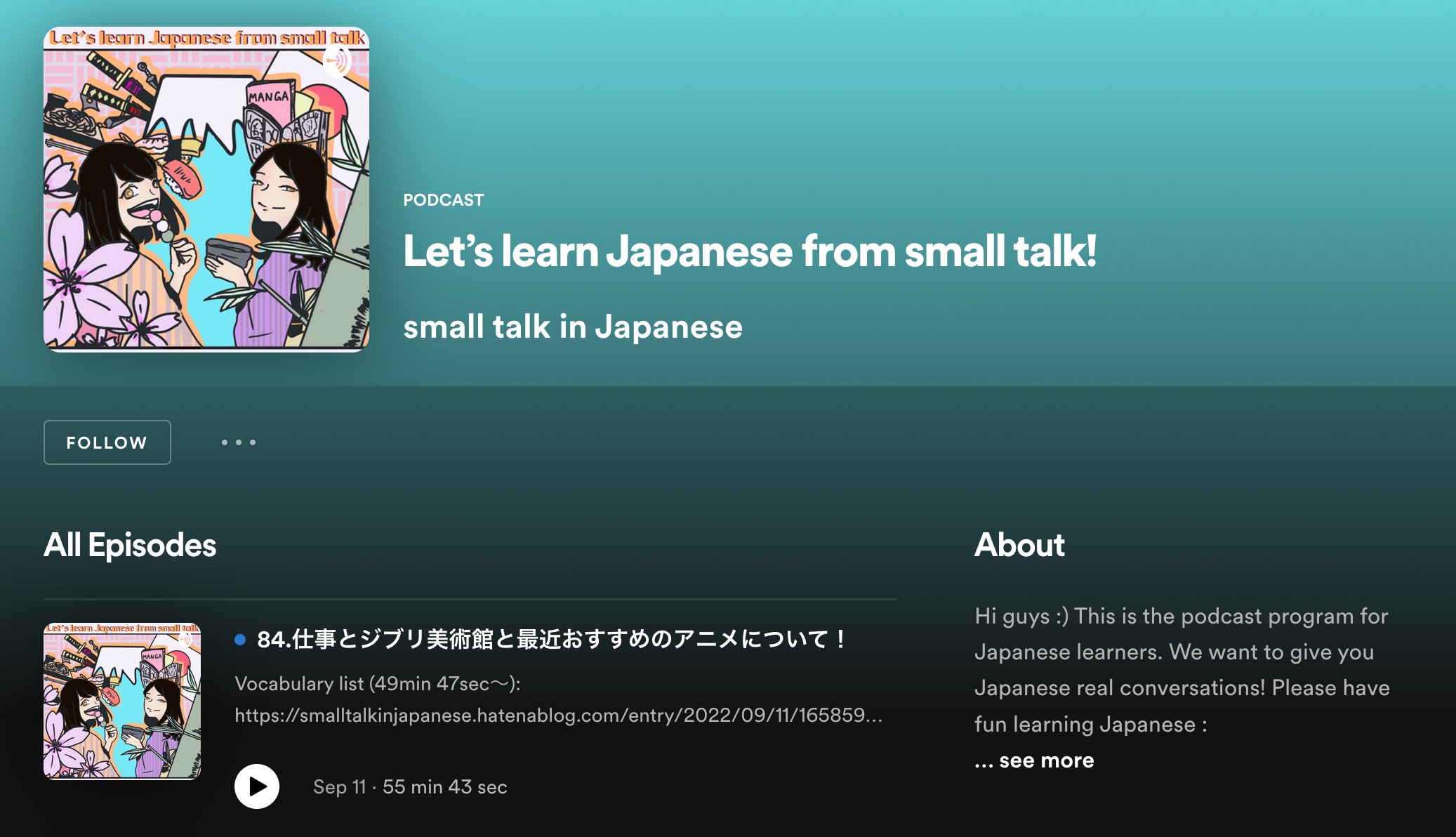
If you're looking for a podcast that offers authentic, everyday Japanese, we recommend you check out Let's Learn Japanese From Small Talk! The podcast is hosted by two native speakers of Japanese, and they cover a wide range of interesting topics about modern life in Japan. We covered this podcast in another Japanese Learning Resources article a year ago, but it has really come into its own since then!
One of my favorite things about the podcast is how well the hosts provide vocabulary support for listeners. Instead of simplifying their Japanese, they provide English translations of difficult words, or explain what words mean using other words in Japanese. At the end of each episode, one of the hosts slowly pronounces each word covered in the episode, leaving enough time in between for listeners to pronounce the words after her. Vocabulary lists for each episode are posted on the podcast blog, which makes this a really great study tool!
I would recommend this podcast to upper-intermediate and advanced learners, however a more beginner level learner could try studying the vocabulary list before listening to the podcast to see if it is more accessible that way. In any case, if you're in need of an enjoyable and informative Japanese podcast, give it a shot!
にほんごボックス
The YouTube channel にほんごボックス launched around a year ago and has been publishing content regularly ever since, meaning they already have over a hundred videos to choose from. The intention behind the channel is to help non-native speakers of Japanese become familiar with natural, everyday language. That is, not the kind of Japanese used in textbooks to illustrate grammar points, but the kind you're most likely to hear on a daily basis in Japan.
Topics covered range from explanations of how to use similar expressions like 気持ちが悪い, 気分が悪い, and 機嫌が悪い (backed up by lots of examples and explained to a reluctant stuffed toy chameleon), interviews with exchange students about their experiences studying Japanese, and closeups on JLPT grammar points.
While the less-than-perfect sound quality and background music can sometimes make the dialogue harder to catch, the host Matsumoto, his guests, and actors doing dialogues, all speak clearly, and the pace is on the slower end of natural speech. Japanese TV-style subtitles are provided for most of the conversations, dialogues and explanations, with furigana added to more advanced kanji like 語彙. Most kanji don't have furigana though, making it good for kanji reading practice too. For intermediate learners out there, this channel is a great resource for improving your practical listening skills while also learning more about study techniques, grammar and everyday expressions, and working on your reading skills to boot!
物の名前ドリル

This fun, attractively-illustrated book is designed to help Japanese children practice their vocabulary and writing skills, so it covers all kinds of nouns that kids in Japan are likely to come across in their everyday lives. As such, it's a great primer on life in Japan, and all the concrete nouns that will help you navigate it more easily!
The book is broken down into eight chapters, each covering a major theme, including food, school, nature, and proverbs. Each chapter consists of double-page spreads showcasing objects and people that fall under one of the eight main topics. In the food chapter, for example, there are sub-topics such as 日本の米料理 (Japanese rice dishes), すし, and 日本のおやつ (Japanese snacks). All the nouns have English translations, and most have a blank space for you to write in the Japanese yourself, with the answers given on a different page. Some of the more advanced words — like 掛け 軸 (hanging scroll) — are simply provided for you, though. There are also little tidbits, quizzes, and word games on most pages, giving extra information about things like etymology and usage. Since it's written for children, the writing style is straightforward and all kanji have furigana.
Even advanced learners might not know the Japanese for "disaster prevention hood" or "lumpfish."
Some of the English translations are questionable, but the illustrations make the meaning crystal clear even when the English doesn't. From a learners' perspective, the vocabulary ranges from the very simple to the downright niche. Even advanced learners might not know the Japanese for "disaster prevention hood" or "lumpfish," for example 🤓. But almost all of them would potentially come in handy if you live in Japan. The vocabulary is obviously child-oriented, so would be also useful if you're planning on spending time with children.
On the flipside, this book is probably not for you if you're looking for exam techniques or business Japanese. It may also not be the most efficient learning tool, but it is a cute and colorful supplementary study resource that's worth checking out if you're intermediate level and currently living in Japan, or planning to do so in the future!
虫眼鏡の放送部
This YouTube channel is home to the 虫眼鏡の虫も殺さないラジオ podcast, which is made for native Japanese speakers and zooms in on a range of subjects, often based on letters from listeners. Typical themes include love and relationship advice, but there are also episodes based around questions like "what is happiness?" — just be warned that some episodes are quite candid and might not be suitable to listen to at work!
Most of the episodes we listened to featured the presenter giving his thoughts in monologue style, but there are sometimes also featured guests, which results in a more interactive style. The register is relatively formal but conversational, and is great for both vocabulary and listening practice. It isn't always easy to find material to practice this kind of everyday, conversational listening at this level, and the fact that these often over hour-long installments are published at least once a week means you're unlikely to run out of material any time soon.
The natural speaking speed and advanced level of language probably make this podcast unsuitable for beginner or intermediate listeners. But if you're an advanced listener looking for authentic listening material that will stand you in good stead for taking part in conversations that go well beyond small talk, you should give this channel a go. You can always turn on the automatically-generated subtitles if you get stuck!
すみっコぐらし はじめての漢字辞典
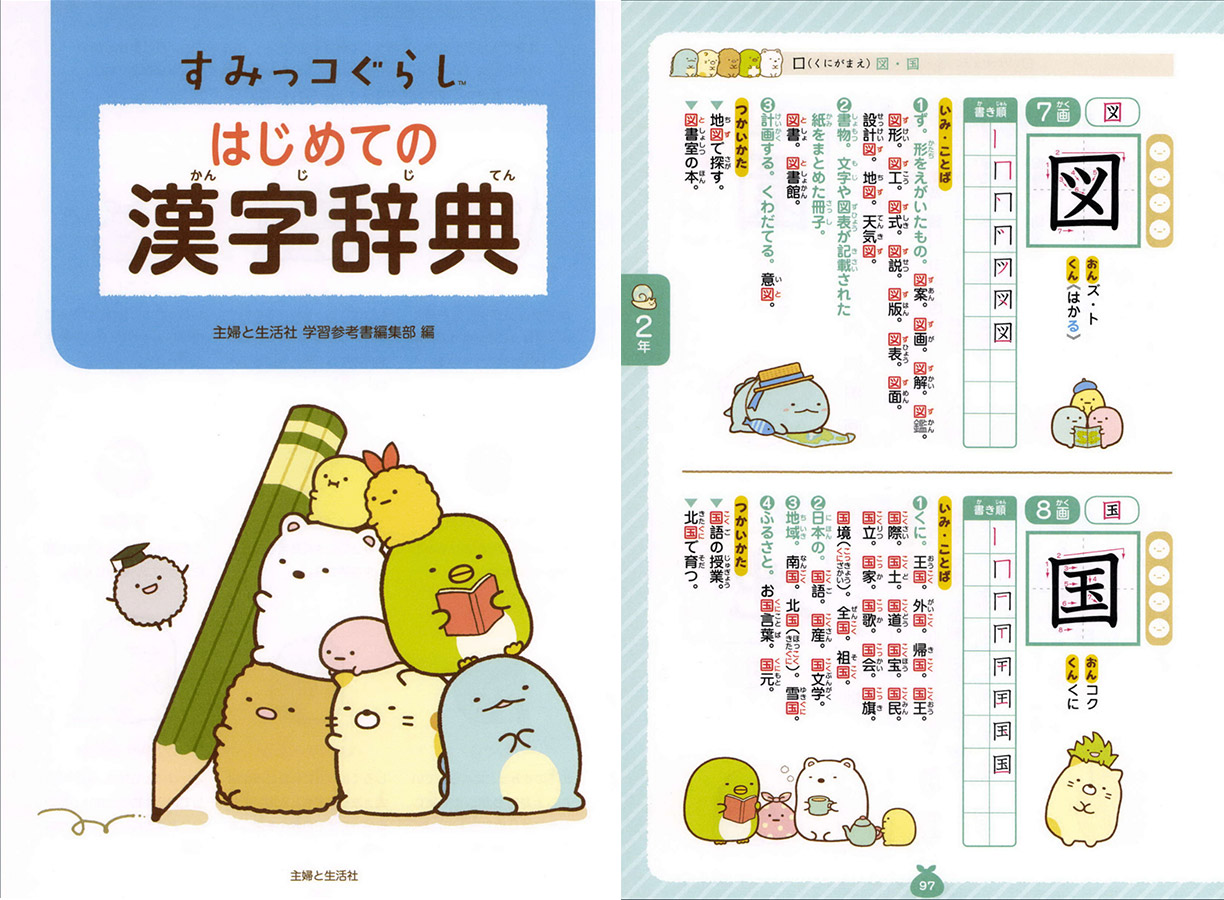
This textbook is likely targeted at Japanese grade school learners who want to learn kanji. The title translates to “Sumikko Gurashi - My First Kanji Dictionary.” Sumikko Gurashi are characters designed by the company San-X. The first section of the textbook is even dedicated to introducing the reader to all of the characters. You can thus quickly (and correctly) assume that this textbook is full of colors and cute animals.
Each kanji description shows the radical, stroke order, readings (on’yomi and kun’yomi), the year it’s taught in Japanese grade school (from grades 1-5), and more. Also helpful are the examples given for special readings, which are those that are rarely used, as well as the “都道府県名,” which tells you of important place names that use the character.
Although this textbook is intended for kanji-learning beginners, for those of us who are learning Japanese from a non-native position, I think it’s more aligned with intermediate-level kanji learners. This is because you have to have some knowledge of kana, kanji, and vocabulary in order to understand what is written. I can see a visual learner benefiting from this style and using it to practice hand-writing kanji. For those that need additional English support, because this book is entirely in Japanese, it likely won’t be the resource for you.
Fluent Forever

Fluent Forever is a program for language learning through personalized flashcard creation and a spaced repetition system (SRS) to attain the goal of “forever” memorization. The system was created by piecing together various effective methods the founder came across and was later made into a popular book. Now that they have an iOS app and the Japanese program, we needed to check it out!
In this program, there are four steps to learning. These are pronunciation lessons, learning vocabulary through images, learning grammar, and practicing with native tutors (currently in development). In designing flashcards, you can choose a photo that best fits with the phrase on the flashcard or you can select one from your camera roll. There is also a learning schedule of tasks to do each day, such as "Complete 20 grammar flashcards" so you know what's on your agenda for the day. The "running streak" indicator as well as the "known word count" may also help to keep you motivated.
This app is probably most beneficial for beginner learners because you're introduced to the language through short informational videos. Also, the images may be helpful for visual learners. I think advanced learners may have a tougher time of jumping in and finding a good balance of learning new content and practicing what they know. I'm eager to see where the program goes with access to native tutoring practice one day.
Gengar Podcasts
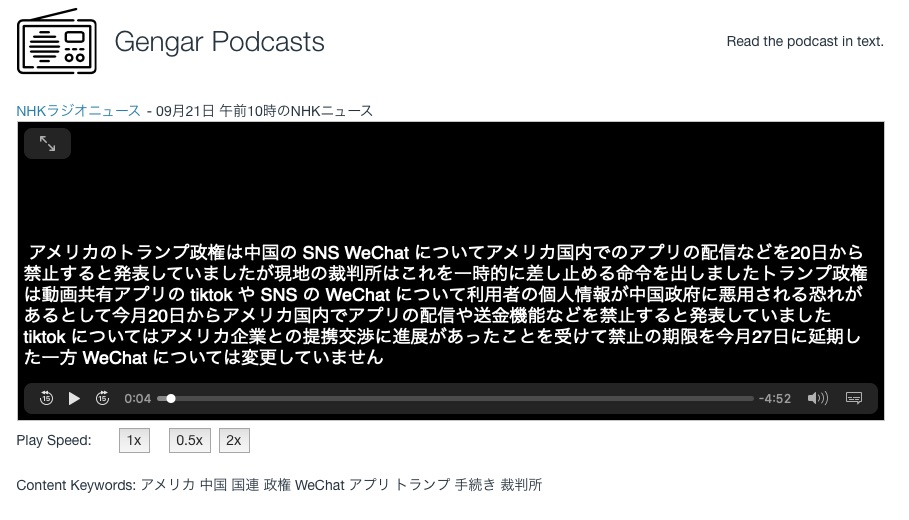
If the name of this learning resource made you think of Gengar the Pokémon, you're not alone. I did too! But as far as I can tell, this webapp has nothing to do with Pokémon. Gengar Podcasts is a website that provides transcriptions of podcast audio, so you can read along as you listen!
At the time we checked this resource, there were eight Japanese podcasts/radio shows available on Gengar Podcasts. It looks like a ninth is being processed: Let's Learn Japanese From Small Talk!. It looks like you can submit podcasts to be processed by Gengar Podcasts, so if you have a favorite Japanese podcast, you can try to get it transcribed using this service!
The transcriptions themselves are not perfect, but it's still nice to be able to read along as you listen, even if a word is missing here and there. Japanese transcriptions lack any punctuation though, so it is very difficult to tell where one sentence ends and another begins. One great feature is the ability to listen at 0.5x speed—slowing down a podcast makes it much easier to follow if you're a non-native speaker.
If you've been trying to get into Japanese podcasts, but just can't follow along without textual aid, Gengar Podcasts is your friend.
YouGlish

The YouTube word search tool, YouGlish, is now available in Japanese. If you want to listen to a way a word is pronounced in real life — or at least in a YouTube video — you can search a word and pull up hundreds of videos with that term. The videos are cued up to start a few seconds before the word is spoken and the transcript appears in large text underneath.
YouGlish allows you to add extra parameters to your search, like filtering by female and male. Although the gender filter works well for Japanese, the parts of speech, phrase type, and hashtag context filters don't work very well on Japanese videos (at least, not yet). There are a few settings as well, like filtering out restricted videos (like YouTube's Kid Mode) and adjusting how many seconds before the word the video starts playing.
Many of the videos that come up first are from popular TEDx Talks, university lectures or videos from Japanese government ministries. But I've also found videos I might not have ever come across otherwise, like weekly bilingual Japanese/English tarot card readings and book reviews.
I've also used YouGlish to look up words I've just learned to see the various ways the words can be used in different contexts. If you create an account and log in, you can save your favorite search terms and videos.
Whether you're practicing pronunciation, hoping to learn how certain words (like さすが) are used in various scenarios, or just want to find high-quality Japanese videos to watch on a specific topic, YouGlish is a good tool to find Japanese video material.
ロールプレーで学ぶビジネス日本語

Experience the life of a new employee in a traditional Japanese transnational corporation, through listening and conversation exercises. Just like the Japanese work year, ロールプレーで学ぶビジネス日本語 will take you through a whole year of meeting room and water cooler conversations with your boss and colleagues from April to March. The book takes role playing to heart — complete with your work assignment, an IT employee from Vietnam, a map of the corporate branches, and a detailed org chart with your new teammates' names, titles and ages.
Aside from the introduction and glossary, which are translated into English, Chinese and Vietnamese, the 160-page book is written in Japanese, with furigana for vocabulary from JLPT N2 level and above. The book covers the basics, from introducing yourself on your first day of work, answering the phone, and apologizing for mistakes in polite, office-appropriate language, to more casual scenarios, like striking up conversations at the bar during a company happy hour. Each of the fourteen chapter lessons in the book includes model exchanges between multiple people, relevant vocabulary, sentence patterns and a multiple-choice or fill-in-the-blank question quiz.
If you're interested in the book, check out the sneak preview of the first few pages to get a feel for the design and the audio conversations from each lesson. The audio is free online to download. If you're not sure if the level of the book is right for you, you can also check out the table of contents and the audio from the intermediate level version of the book.
Nあ~ Casual Nihongo
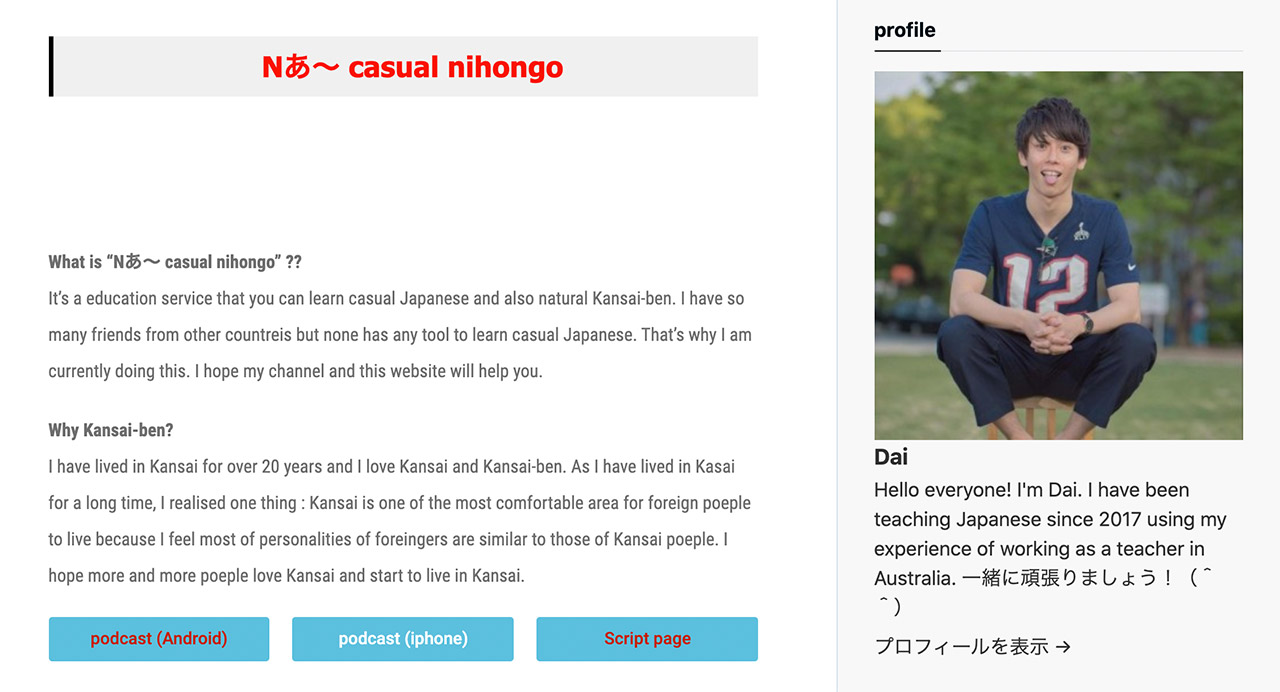
Looking for listening materials for Kansai-ben (i.e. dialect)? Check out Nあ~ Casual Nihongo, a great podcast channel for those who are eager to learn Kansai-ben!
In each episode, the Kansai-ben speaking host, Dai, plays audio of a short conversation in Kansai-ben, and provides commentary on it. These conversations are real, natural conversation, which almost makes you feel like you're a fly on the wall in an Osaka izakaya. In addition to explaining useful vocabulary and phrases, Dai also quizzes listeners so they can check their understanding of the conversation.
For beginners out there, or if you're new to Kansai-ben, the conversations might be a little challenging. But if you're an intermediate or advanced learner with some exposure to Kansai-ben, be sure to give it a try!
That's all for this fall edition. Thank you for reading and we hope you enjoyed it! If you discover any new Japanese learning resources, send us a message at hello@tofugu.com or on Twitter @tofugu. Even if it's just new to you, send it our way. We're always on the lookout for quality resources. We'll see you for the winter edition. Ciao!
